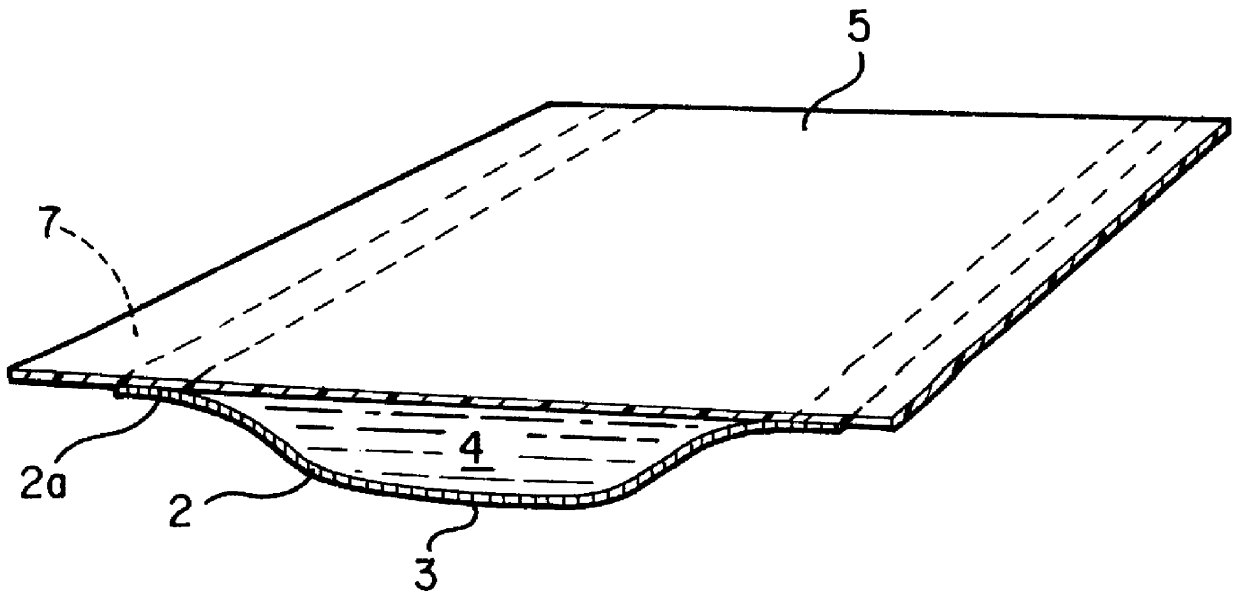Bioreactor wound dressing
- Summary
- Abstract
- Description
- Claims
- Application Information
AI Technical Summary
Benefits of technology
Problems solved by technology
Method used
Image
Examples
example 1
The dressing 1 is described in the FIG. 2 where 2 is the transport layer from the permeable material described below; 5 is the protective layer that is connected to the periphery zone 2a of the transport layer 2, forming a space wherein an aqueous liquid comprising a hydrogel dispersion is confined. That space is filled with the liquid forms the Reservoir Layer 4.
The protective layer 5 is made of a commercial foil of clear polyurethane polymer covered by a thin layer of acrylic pressure-sensitive adhesive.
The transport layer 2 is made from a highly permeable acrylic hydrogel based on a partially hydrolyzed polyacrylonitrile. The partial hydrolysis of polyacrylonitrile is carried out by a basic catalyst and yields a multiblock copolymer containing residual nitrile groups, sodium carboxylate groups, amidine groups and amide groups in such a proportion that the liquid content in the hydrogel is more than 90% by weight in the equilibrium with 0.9% by weight of NaCl aqueous solution. The...
example 2
The dressing from the Example 1 can be used for keratinocyte cultivation for wound healing. The transport layer is modified by exposure to bovine serum for 48 hours from the cultivation surface side. The dressing is then surface dried, packaged into a semipermeable poach and autoclaved for 30 minutes at 123.degree. C. The deposited layer of denatured proteins on the cultivation surface improves adhesion of cells in the subsequent steps. The procedure is carried out in the following steps:
1) A biopsy sample is taken from the skin of a patient suffering by a chronic or acute wound. The skin sample is treated with trypsin to release keratinocytes.
2) The dressing's 1 cavity 4 is filled with the solution A and placed into a Petri dish filled with the solution A. The dressing is turned so that the cultivation surface faces upwards. 3T3 mouse fibroblasts are irradiated by a lethal dose of Gamma radiation and seeded onto the cultivation surface.
3) After 24 hours in an incubator at 37.degree...
example 3
The transport layer is made from a hydrogel prepared by the following method:
100 weight parts (w.p.) of 2-hydroxyethylmethacrylate monomer (HEMA), 450 weight parts of water, 450 weight parts of ethyl alcohol and 3 w. p. of hydrogen peroxide was stirred for 8 hours at 65.degree. C. under reflux condenser and nitrogen protective atmosphere. The resulting viscous solution is cooled and poured into an excess of water. The white precipitate is formed and washed in deionized water for several days. The purified uncrosslinked HEMA polymer (PHEMA-S) is cut to small pieces and dried at 60.degree. C. to constant weight. The resulting glassy polymer is ground to a crude powder and stored in closed containers.
10 w.p. of the PHEMA-S powder is dissolved in 80 w.p. of ethyl alcohol, 5 parts of water, 5 parts of 1,2 propylene glycol and 0.1 part of phosphoric acid. This solution is spread into a thin layer over a polyester mesh, let dry at 60.degree. C. for 3 hours and then heated to 120.degree. C....
PUM
| Property | Measurement | Unit |
|---|---|---|
| Fraction | aaaaa | aaaaa |
| Fraction | aaaaa | aaaaa |
| Percent by mass | aaaaa | aaaaa |
Abstract
Description
Claims
Application Information
 Login to View More
Login to View More - R&D
- Intellectual Property
- Life Sciences
- Materials
- Tech Scout
- Unparalleled Data Quality
- Higher Quality Content
- 60% Fewer Hallucinations
Browse by: Latest US Patents, China's latest patents, Technical Efficacy Thesaurus, Application Domain, Technology Topic, Popular Technical Reports.
© 2025 PatSnap. All rights reserved.Legal|Privacy policy|Modern Slavery Act Transparency Statement|Sitemap|About US| Contact US: help@patsnap.com



